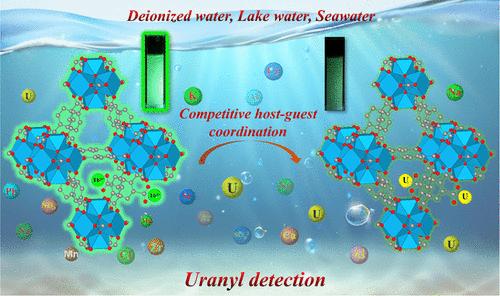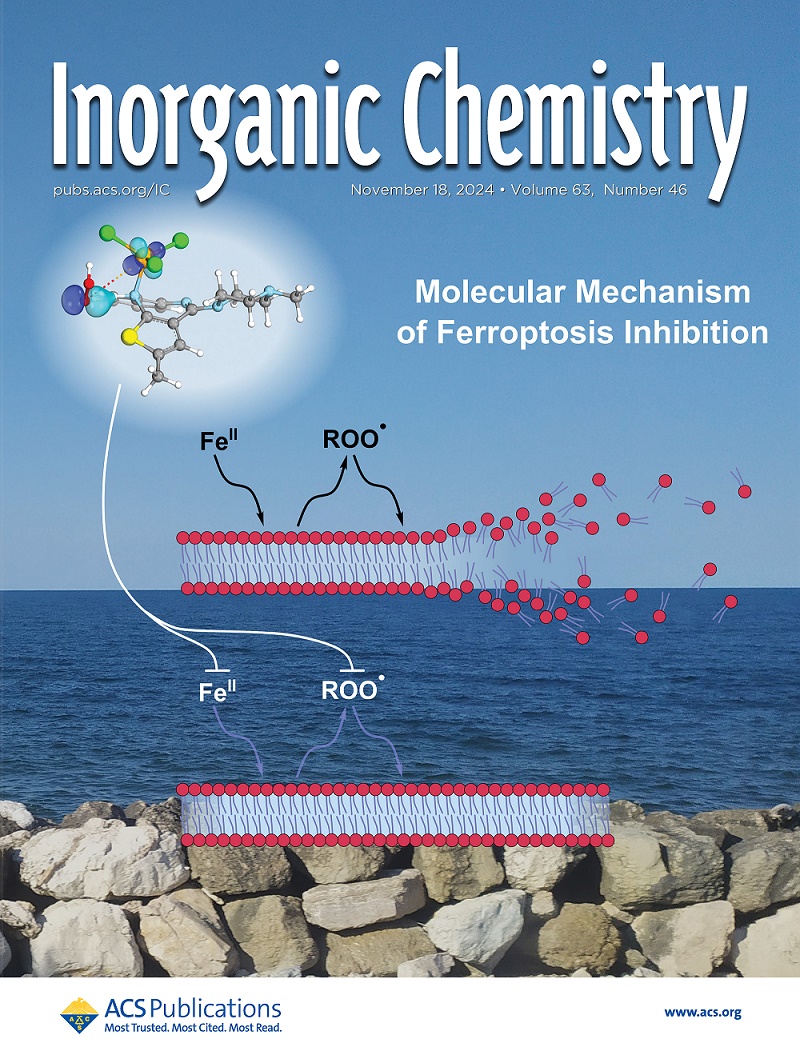Highly Sensitive and Selective Detection of Uranyl Ions Based on a Tb3+-Functionalized MOF via Competitive Host–Guest Coordination
IF 4.3
2区 化学
Q1 CHEMISTRY, INORGANIC & NUCLEAR
引用次数: 0
Abstract
Owing to the rapid development of the nuclear industry, uranium has become a global environmental contaminant due to its radiotoxicity and chemotoxicity, posing significant threats to human health and ecological safety. Although various instrumental and chemical analytical methods have been developed for uranyl ion detection in aquatic environments, searching for new sensors with high stability, sensitivity, and selectivity remains a challenge. In this study, a luminescent Zr-based metal–organic framework (MOF), designated as Tb@UiO-66-(COOH)2, was successfully synthesized utilizing a postsynthetic exchange (PSE) method along with Tb3+ ion doping for uranyl ion detection. Interestingly, the presence of UO22+ ions causes a replacement of guest ions (Tb3+) in the sensor via a competitive host–guest interaction, leading to significant luminescence quenching. The attenuation of the luminescence intensity of Tb@UiO-66-(COOH)2 exhibits an excellent linear relationship with UO22+ ion concentrations within a wide range of 0–2.52 μM. Notably, Tb@UiO-66-(COOH)2 demonstrates an unprecedentedly high detection sensitivity (Ksv = 2.16 × 105 M–1) and an extremely low limit of detection (LOD) down to 8.03 nM (1.91 ppb) in deionized water. More importantly, Tb@UiO-66-(COOH)2 can achieve high selectivity and efficient detection performance, even in the presence of significant excesses of competing ions. The values of Ksv were determined to be 2.10 × 105 M–1 in Xie’ao Lake water and 3.05 × 105 M–1 in seawater; the values of LOD were determined to be 8.26 nM (1.96 ppb) in Xie’ao Lake water and 5.68 nM (1.35 ppb) in seawater. To the best of our knowledge, this is the first instance of introducing a competitive host–guest coordination strategy into a MOF-based chemical sensor to achieve high-performance uranyl ion detection. Hence, the present work offers a novel idea for building functional MOFs for uranyl ion detection in aqueous solutions.

由于核工业的快速发展,铀因其放射性毒性和化学毒性已成为一种全球性的环境污染物,对人类健康和生态安全构成了重大威胁。尽管目前已开发出多种仪器和化学分析方法来检测水生环境中的铀离子,但寻找具有高稳定性、高灵敏度和高选择性的新型传感器仍是一项挑战。本研究采用后合成交换(PSE)方法,掺杂 Tb3+ 离子,成功合成了一种发光的 Zr 基金属有机框架(MOF),命名为 Tb@UiO-66-(COOH)2,用于铀酰离子检测。有趣的是,由于 UO22+ 离子的存在,传感器中的客体离子(Tb3+)会通过竞争性的主客体相互作用被取代,从而导致显著的发光淬灭。在 0-2.52 μM 的宽范围内,Tb@UiO-66-(COOH)2 的发光强度衰减与 UO22+ 离子浓度呈良好的线性关系。值得注意的是,Tb@UiO-66-(COOH)2 在去离子水中表现出前所未有的高检测灵敏度(Ksv = 2.16 × 105 M-1)和极低的检测限(LOD),最低可达 8.03 nM(1.91 ppb)。更重要的是,Tb@UiO-66-(COOH)2 可以实现高选择性和高效检测性能,即使在竞争离子明显过量的情况下也是如此。经测定,谢鳌湖水中的 Ksv 值为 2.10 × 105 M-1,海水中的 Ksv 值为 3.05 × 105 M-1;经测定,谢鳌湖水中的 LOD 值为 8.26 nM(1.96 ppb),海水中的 LOD 值为 5.68 nM(1.35 ppb)。据我们所知,这是首次在基于 MOF 的化学传感器中引入竞争性主-客配位策略以实现高性能铀离子检测的实例。因此,本研究为构建用于水溶液中铀离子检测的功能性 MOFs 提供了一个新思路。
本文章由计算机程序翻译,如有差异,请以英文原文为准。
求助全文
约1分钟内获得全文
求助全文
来源期刊

Inorganic Chemistry
化学-无机化学与核化学
CiteScore
7.60
自引率
13.00%
发文量
1960
审稿时长
1.9 months
期刊介绍:
Inorganic Chemistry publishes fundamental studies in all phases of inorganic chemistry. Coverage includes experimental and theoretical reports on quantitative studies of structure and thermodynamics, kinetics, mechanisms of inorganic reactions, bioinorganic chemistry, and relevant aspects of organometallic chemistry, solid-state phenomena, and chemical bonding theory. Emphasis is placed on the synthesis, structure, thermodynamics, reactivity, spectroscopy, and bonding properties of significant new and known compounds.
 求助内容:
求助内容: 应助结果提醒方式:
应助结果提醒方式:


